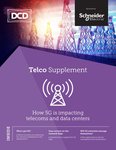5G mobile networks are set to boost infrastructure resilience and performance in all sorts of industries through the enablement of predictive maintenance solutions that quickly identify potential faults and encourage equipment owners to rectify them before components actually break. But the same model which can recognize emerging faults and error conditions and rectify them before they cause disruption or outages can also be applied to 5G networks themselves to ensure stable network operation and minimize downtime which could bring many of those increasingly smart connected industries to a halt.
The migration away from third (3G) and fourth generation (4G) network infrastructure to 5G equivalents over the next five years will be a gradual process. And there is no doubt that telcos and mobile network operators (MNOs) will encounter a lot more complexity in the journey, both in terms of designing and implementing new network topologies and establishing administration processes which rely more heavily on software defined networking (SDN) and virtualized cloud-hosted IT architectures to facilitate the change.
Virtual network functions for example (VNFs) will become more critical to network management requirements which span complex hybrid configurations that mix 5G equipment alongside fourth (5G) and third generation (3G) components to maximize density and coverage, at least in the early years before standalone 5G NR networks which use 5G cells for both signaling and information transfer start to take over.
Self healing networks and predictive maintenance
Automation too will play an increasingly critical role in 5G network configuration, provisioning and quality of service (QoS) delivery, as well as feeding back actionable insight to operators which can be used to optimize resilience and performance. Telcos are also looking at where machine learning (ML) algorithms can adapt systems to cope with traffic fluctuations based on the analysis of historical usage data patterns which predict where problems are likely to occur.
The 5GPPP has proposed a framework and key performance indicators (KPIs) for 5G network management which includes CogNet and SelfNet for example. CogNet uses ML to optimize NFV and SDN functions through the dynamic configuration of management policies based on ML models, while SelfNet focuses on the concept of the self-organizing network - including self-monitoring, self-optimization, self-protection and self-healing to maintain 5G stability and performance.
Elsewhere the TM Forum – a global alliance of over 850 technology companies – has developed a blueprint for the migration of telcos' legacy IT systems to modular, cloud native software orchestrated using artificial intelligence (AI). Nor is the 5G radio access network (RAN) the only consideration - changes to the operation and management (O&M) platforms which configure the fronthaul and backhaul links that connect and aggregate traffic from 5G base stations and micro sites may also be required. Several telecommunications suppliers have revamped their solutions specifically for 5G network management, including Huawei which has built an optical transport networking (OTN) system that uses electronic optical time domain reflectometers (OTDRs) which scan for abnormal wavelength spans to remotely locate faults on fiber networks without needing to conduct onsite tests.
The TM Forum’s Open Digital Framework has been used by China Mobile to establish a multi-vendor 5G O&M ecosystem in Guangdong province to aid fast fault identification, demarcation and recovery. It also uses an AI training model to improve the network’s self-healing capability by analyzing historical data pertaining to service level agreement (SLA) issues and automatically diagnosing future problems.
Cognitive network management also has an important role to play in the deployment of network slicing – virtualized bundles of 5G network functions and radio access technologies which provide all the tools the network needs to operate and which can be provisioned, deployed and removed dynamically according to demand. Different 5G network slices will be packaged specifically for individual uses cases and depend on MNOs being able to deliver and maintain QoS levels defined by the application or workload in question – a key capability if telcos are to successfully target different industry verticals with services optimized for their particularly requirements.
Network sustainability management
Keeping close track of 5G power consumption is necessary to keep networks both operational and cost effective for their owners. That is likely to require an additional layer of energy management and monitoring solutions which not only collect data on power usage and CPU loads but also traffic routing paths and load levels, user throughput and session numbers, radio coverage, interference parameters and equipment activation intervals. With that data on board, operators can then define a virtual 5G infrastructure energy usage model which can be further analyzed and optimized using ML to highlight the most efficient approach to load balancing and frequency bandwidth assignment in any one 5G service delivery scenario.
A survey of 105 global telecommunications operators carried out by 451 Research and commissioned by data center infrastructure and services specialist Vertiv in 2019 found 81 percent planned to deploy AI/ML solutions in conjunction with data center infrastructure management (DCIM) to help them save on energy consumption and cost by 2024. The ability to remotely monitor and manage edge compute locations and other elements of 5G network and IT infrastructure was also considered essential by the majority.
DCIM was the most important technology for achieving operational and profitability goals cited by 55 percent of respondents of those taking part in the 451 survey. Those capabilities are more important for 5G networks than equivalent 4G infrastructure due to the greater reliance on edge compute nodes, or micro data centers, that are needed to deliver the local data hosting and processing resources essential to meeting low latency 5G application and workload performance requirements.
A big majority (84 percent) of the 451 respondents reported that that they were either already deploying multi access edge (MEC) infrastructure (37 percent) or planned to so at some point in the future (47 percent). The scale of that interest has lead to estimates from Global Market Insights which suggest that revenue from sales of edge data center equipment and platforms (including hardware, software and supporting infrastructure such as cooling and power systems) will grow at a compound annual growth rate (CAGR) of 23 percent over the next five years to be worth US$20bn by 2026.
The DCIM segment within that forecast is expected to grow at an even faster rate (28 percent) as telcos, MNOs and other companies try to improve the way they monitor and manage equipment and environmental conditions in the large numbers of Edge compute facilities to help maintain network uptime. DCIM will also deliver integrated energy management capabilities which will help drive power efficiencies in those remote nodes and provide a single interface to replace multiple standalone tools and databases used to collect and review operational data which can make it difficult to obtain information around data center health and energy efficiency quickly enough to make adjustments on the fly.
The pace of migration is uneven across various regions of the world, but global telecommunications networks are largely at the beginning of their 5G migration. As the reach and capacity of that 5G infrastructure gradually expands and billions of new users and devices get connected, the pressure on management systems to deliver operational efficiencies will only increase in tandem.




